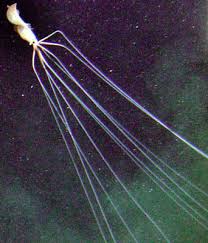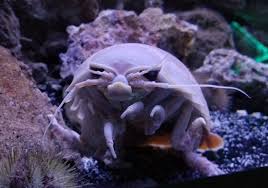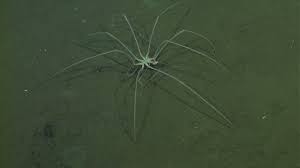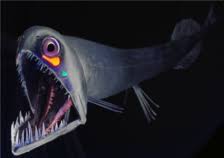welcome to the deep..
the bigfin squid

Bigfin squids are a group of rarely seen cephalopods with a distinctive morphology. They are placed in the genus Magnapinna and family Magnapinnidae. Although the family was described only from larval, paralarval, and juvenile specimens, numerous video observations of much larger squid with similar morphology are assumed to be adult specimens of the same family.
Magnapinna is thought to be the deepest-occurring squid genus, with sightings as deep as 6,212 metres (20,381 ft) below the surface, making it the only squid known to inhabit the hadal zone.
the giant isopod

A giant isopod is any of the almost 20 species of large isopods in the genus Bathynomus. They are abundant in the cold, deep waters of the Atlantic, Pacific, and Indian Oceans. Bathynomus giganteus, the species upon which the generitype is based, is often considered the largest isopod in the world, though other comparably poorly known species of Bathynomus may reach a similar size (e.g., B. Kensleyi).The giant isopods are noted for their resemblance to the much smaller common woodlouse (pill bug), to which they are related.
Giant isopods are a good example of deep-sea gigantism (cf. giant squid), as they are far larger than the "typical" isopods that are up to 5 cm (2.0 in). Bathynomus can be divided into "giant" species where the adults generally are between 8 and 15 cm (3.1 and 5.9 in) long and "supergiant" species where the adults are typically between 17 and 50 cm (6.7 and 19.7 in).
the seaspider

Sea spiders are marine arthropods of the order Pantopoda they are cosmopolitan, found in oceans around the world. The over 1,300 known species have leg spans ranging from 1 mm (0.04 in) to over 70 cm (2.3 ft).Most are toward the smaller end of this range in relatively shallow depths; however, they can grow to be quite large in Antarctic and deep waters.
Although "sea spiders" are not true spiders, nor even arachnids, their traditional classification as chelicerates would place them closer to true spiders than to other well-known arthropod groups, such as insects or crustaceans, if correct. This is disputed, however, as genetic evidence suggests they may be a sister group to all other living arthropods
the stoplight loosejaw/viperfish

The stoplight loosejaws are small, deep-sea dragonfishes of the genus Malacosteus, classified either within the subfamily Malacosteinae of the family Stomiidae, or in the separate family Malacosteidae. They are found worldwide, outside of the Arctic and Subantarctic, in the mesopelagic zone below a depth of 500 meters (1,600 feet). This genus once contained three nominal species: M. niger (the type), M. choristodactylus, and M. danae, with the validity of the latter two species being challenged by different authors at various times. In 2007, Kenaley examined over 450 stoplight loosejaw specimens and revised the genus to contain two species, M. niger and the new M. australis.
alacosteus and the related genera Aristostomias, Chirostomias and Pachystomias are the only fishes that produce red bioluminescence. As most of their prey organisms are not capable of perceiving light at those wavelengths, this allows Malacosteus to hunt with an essentially invisible beam of light. Furthermore, Malacosteus is unique amongst animals in using a chlorophyll derivative to perceive red light.